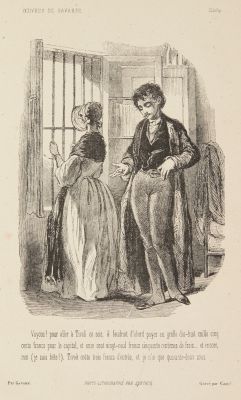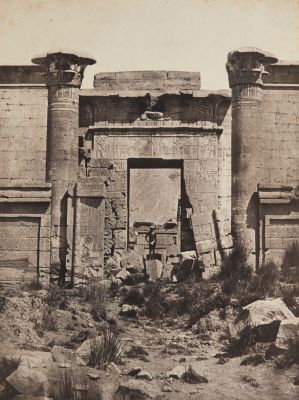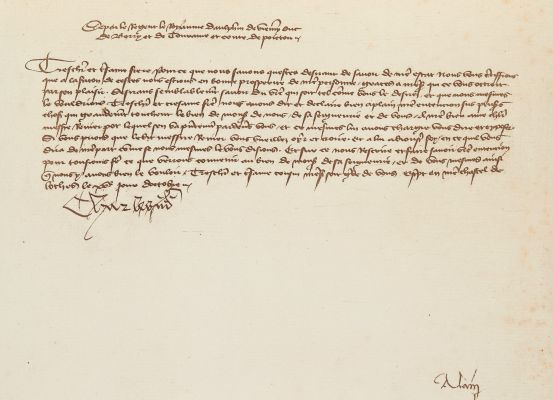
Title
“Milon de Crotone”, sculpture by Etienne Maurice FalconetArtist
Baldus, Edouard (French, 1813-1889)Publication
La Photographie: Ses Origines, Ses Progres, Ses Transformations.Date
1869Process
Photogravure (heliogravure)Atelier
Baldus, EdouardImage Size
19.1 x 16 cmSheet Size
31 x 24 cm
‘We have in photography a discovery which is to art what the printing press was to literature‘ The Photographic Times 1862
In 1869, in his La photographie. Ses origines, ses progrès, ses transformations, Blanquart-Évrard offered two photogravures by Baldus as proof of what photography can do for art and science. One was a facsimile from his Raimondi series, the other this astonishing image of Étienne-Maurice Falconet’s “Milon de Crotone” of 1754, a sculpture in the Louvre. Baldus captures Falconet’s marble sculpture in all its dynamism and drama, the moment of the defeated hero’s savage end aglow against surrounding darkness, as though on a theater stage. The image was one of the first “from nature” that Baldus published as a photogravure. True to form, he wrote nothing about this shift in his production, but the print proclaims it with all the force of Milo’s straining body. Baldus was entering this new field with the intention of mastery. [1]
Blanquart-Évrard, a cloth merchant from Lille, France who took up the calotype process and in 1847 published a method for a negative/positive paper process and began printing and publishing the works of other photographers. His ‘Imprimerie Photographique’ opened in 1851 in Loos-lès-Lille and was the first of its kind in France, with his production higher than that of Talbot in England. By taking advantage of his own innovations he was able to print two or three hundred prints a day from the same negative and this rapid production allowed the creation of salt paper prints that could be tipped-in to books that he published. Key books and albums of prints by John Beasly Greene, Charles Marville and Henri Le Secq were printed by Blanquart-Évrard. However, his original estimate of the costs involved in operation fell well short, and by 1855 he closed his factory. A partnership with Thomas Sutton in Jersey began in September of 1855, and closed in 1857. In 1856 with Thomas Sutton he founded the magazine Photographic Notes, a journal which continued for eleven years.
La Photographie: Ses Origines, Ses Progres, Ses Transformations, is considered to be Blanquart-Évrard’s most enduring work. The work contains a discussion of the genesis of photomechanical printing and photo-typographic illustration and is accompanied by contemporary examples: The text of this treatise was the first to explore the significance that these new processes were eventually going to have in printing and publishing. Blanquart-Evrard clearly understood that the ink-based image would eventually completely replace silver-based printing in publishing. [2]
The original mounted plates include: Blanquard-Évrard’s 1852 printing of a Maxime Du Camp photograph from Egypte, Nubie, Palestine et Syrie; photo-lithographs by Zurcher; a heliogravure by Baldus; carbon prints by Ernest Edwards and Alphonse Braun, et al.
There are three different editions with this title; one is of a smaller format, and a second quarto edition appeared in a print run of fifty numbered copies in 1870. Most copies of this first quarto edition of 1869 have fourteen plates. This copy is inscribed to his children. WorldCat locates only two copies of this edition: Rijkmuseum, and the Bibliotheque Nationale de France. Roosens and Salu No. 928
Reproduced / Exhibited
Addleman-Frankel, Kate, Saskia Asser, and Édouard Baldus. After Photography?: The Photogravures of Édouard Baldus Reconsidered. , 2018. fig. 1.
References
[1] Addleman-Frankel, Kate. Dividing Lines – Early Photogravure, Reproduction, and the History of Photography, Doctor of Philosophy Department of Art History University of Toronto 2019 p. 127
[2] Hanson, David A. The David A. Hanson Collection of the History of Photomechanical Printing. The Sterling and Francine Clark Art Institute. Catalog 2000 p. 36.











